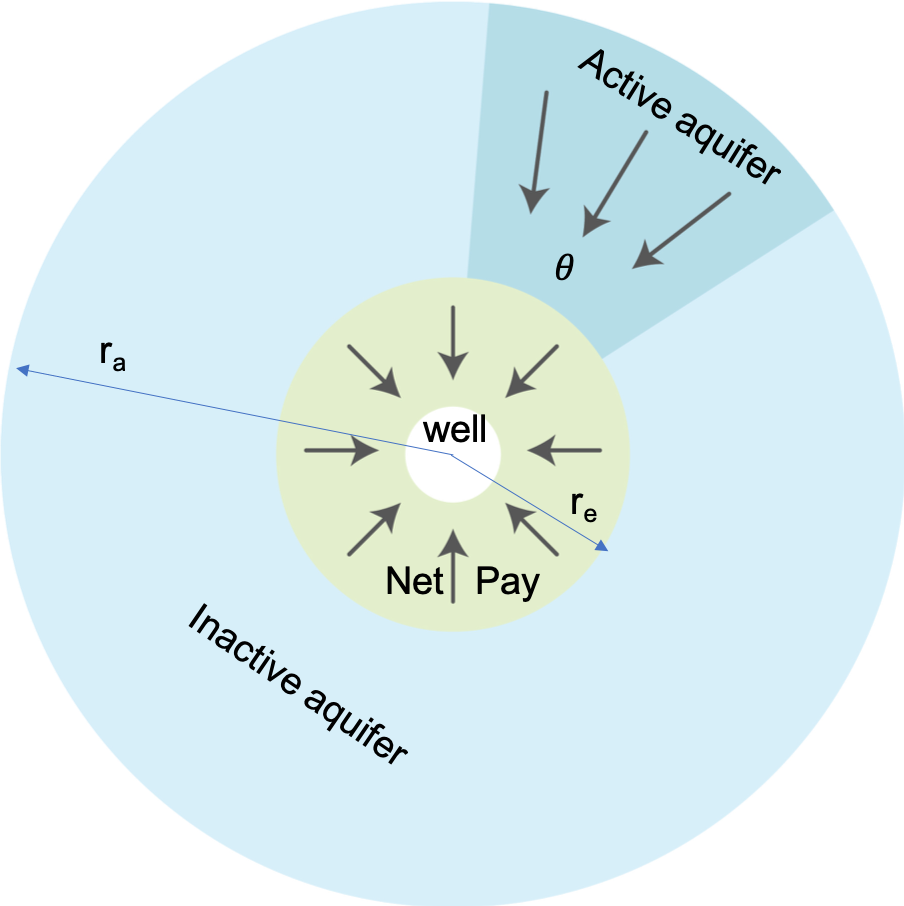Motivation
...
| Excerpt Include |
|---|
| Aquifer Drive |
|---|
| Aquifer Drive |
|---|
| nopanel | true |
|---|
|
Inputs & Outputs
...
...
...
...
...
...
Physical Model
...
in Radial Composite Reservoir ...
Mathematical Model
...
1\frac{d }{dt} = q^{\downarrow}_{AQ}(t)= B \cdot \int_0^t W_{eD} \left( \frac{(t-\tau)\chi}{r_e^2}\right) \dot p(\tau) d\tau |
| |
1q^{\downarrow}AQC_a \cdot\int_0^{t} \frac{\partial p_ |
|
a(t,r)1}{\partial r_D} \bigg|_{r |
|
=r_e}CTp_a, rp(0) + int_0^t p_1 \left(\(t-\tau) \cdot \chi}{r_e^2}, \frac{r}{r_e} \right) \dot p(\tau) d\taudQ^{\downarrow}_{AQ}}{dt} |
| | LaTeX Math Block |
|---|
| p_1 = p_1(t_D, r_D) |
|
|
RC | \frac{\partial p_1}{\partial t_D} = \frac{\partial^2 p_1}{\partial r_D^2} + \frac{1}{r_D}\cdot \frac{\partial p_1}{\partial r_D} |
| | LaTeX Math Block |
|---|
| p_1(t_D = 0, r_D)= 0 |
| | LaTeX Math Block |
|---|
| p_1(t_D, r_D=1) = 1 |
| |
1 | \frac{\partial p_1(t_D, r_D)}{\partial r_D}
\ |
|
bigg _a/r_e}or | LaTeX Math Block |
|---|
| p_1(t_D, r_D = \infty) = 0 |
|
Computational Model
...
...
| Q^{\downarrow}_{AQ}(t)= B \cdot \sum_\alpha W_{eD}
\left( \frac{ (t-\tau_\alpha) \chi}{ |
|
...
r_e^2} \right)\Delta p_\alpha
= B \cdot W_{eD}
\left( \frac{ (t-\tau_1) \chi}{r_e^2} \right)\Delta p_1 +
B \cdot W_{eD}
\left( \frac{ (t-\tau_2) \chi}{r_e^2} \right)\Delta p_2
+ ... + B \cdot W_{eD}
\left( \frac{ (t-\tau_N) \chi}{r_e^2} \right)\Delta p_N |
|
This computational model is using a discrete convolution (also called superposition in some publications) with time-grid
| LaTeX Math Inline |
|---|
| body | \{ \tau_1, \, \tau_2, \ ... \ , \tau_N \} |
|---|
|
.In practical exercises with manual or spreadsheet-assisted calculations the time-grid is usually uniform:
| LaTeX Math Inline |
|---|
| body | \{ \tau_1 =\Delta \tau, \, \tau_2 = 2 \cdot \Delta \tau, \ ... \ , \tau_N = N \cdot \Delta \tau\} |
|---|
|
with the time step of a month to ensure the formation pressure does not change much since the previous time step.Moving to annual time step may accumulate a substantial mistake if formation pressure has varied substantially in some years.
| Expand |
|---|
| title | Polynomial approximations for WeD |
|---|
|
Polynomial approximation of are available (http://dx.doi.org/10.2118/15433-PA).
Table 1. Polynomial approximation of for infinite aquifer | | LaTeX Math Inline |
|---|
| body | W_{eD}=\sqrt{\frac{t_D}{\pi}} |
|---|
|
| | | LaTeX Math Inline |
|---|
| body | \displaystyle W_{eD}=\frac {1.2838 \cdot t_D^{1/2} + 1.19328 \cdot t_D +0.269872 \cdot t_D^{3/2} +0.00855294 \cdot t_D^2} {1+0.616599 \cdot t_D^{1/2}+0.0413008 \cdot t_D} |
|---|
|
| | | LaTeX Math Inline |
|---|
| body | \displaystyle W_{eD}=\frac{-4.29881+2.02566 \cdot t_D}{\ln t_D} |
|---|
|
|
|
Scope of Applicability
...
The benefit of VEH approach is that net pay formation pressure history
is usually known so that water influx calculation based on aquifer properties | LaTeX Math Inline |
|---|
| body | \{ B, \, r_a, \, \chi \} |
|---|
|
is rather straightforward.In the past the VEH approach was considered as tedious in calculating superposition during the manual exercises.
In modern computers the convolution is a fast fully-automated procedure and VEH model is considered as a reference in the range of analytical aquifer models.
Although the model is derived for linear and radial flow it also shows a good match for bottom-water drive depletions.
See Also
...
Petroleum Industry / Upstream / Subsurface E&P Disciplines / Field Study & Modelling / Aquifer Drive / Aquifer Drive Models
Reference
...
1. van Everdingen, A.F. and Hurst, W. 1949. The Application of the Laplace Transformation to Flow Problems in Reservoirs. Trans., AIME 186, 305.
...
